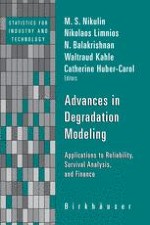William Q. Meeker has made pioneering and phenomenal contributions to the general areaofreliabilityand,inparticular,tothetopicsofdegradationandacceleratedtesting. Hisresearchpublicationsandthenumerouscitationshehasreceivedoverthepastthree decades provide an ample testimony to this fact. Statistical methods have become critical in analyzing reliability and survival data. Highly reliable products have necessitated the development of accelerated testing and degradation models and their analyses. This volume has been put together in order to (i) review some of the recent advances on accelerated testing and degradation, (ii) highlight some new results and discuss their applications, and (iii) suggest possible directions for future research in these topics. With these speci?c goals in mind, many authors were invited to write a chapter for this volume. These authors are not only experts in lifetime data analysis, but also form a representative group from former students, colleagues, and other close professional associates of William Meeker. All contributions have been peer reviewed and organized into 26 chapters. For the convenience of readers, the volume has been divided into the following six parts: • Review, Tutorials, and Perspective • Shock Models • Degradation Models • Reliability Estimation and ALT • Survival Function Estimation • Competing Risk and Chaotic Systems Itneedstobeemphasizedherethatthisvolumeisnotaproceedings,butacarefully anddeliberatelyplannedvolumecomprisingchaptersconsistentwiththeeditorialgoals and purposes mentioned above. Our thanks go to all the authors who have contributed to this volume. Thanks are also due to Mrs. Debbie Iscoe for the excellent typesetting of the entire volume. SpecialthanksgotoMs.ReginaGorenshteynandMr.TomGrasso(Editor,Birkh¨ auser, Boston) for their interest and support for this project.
